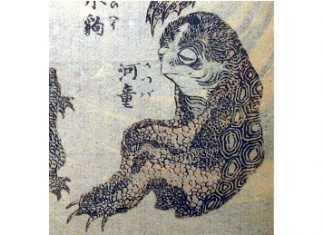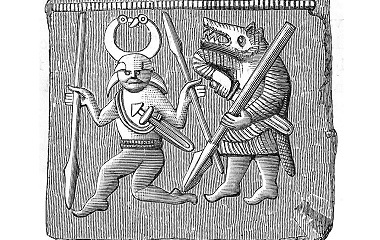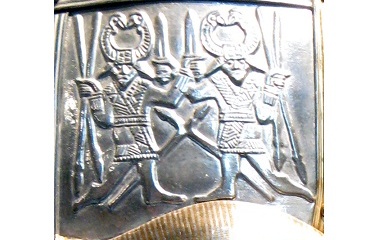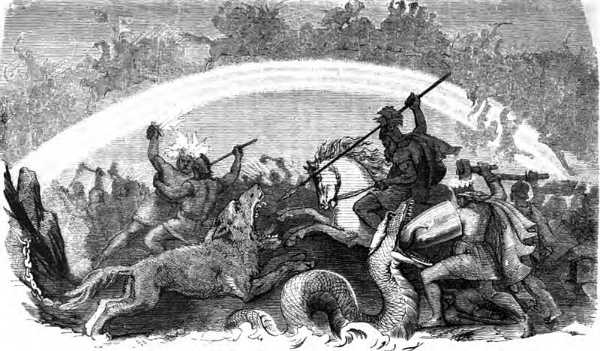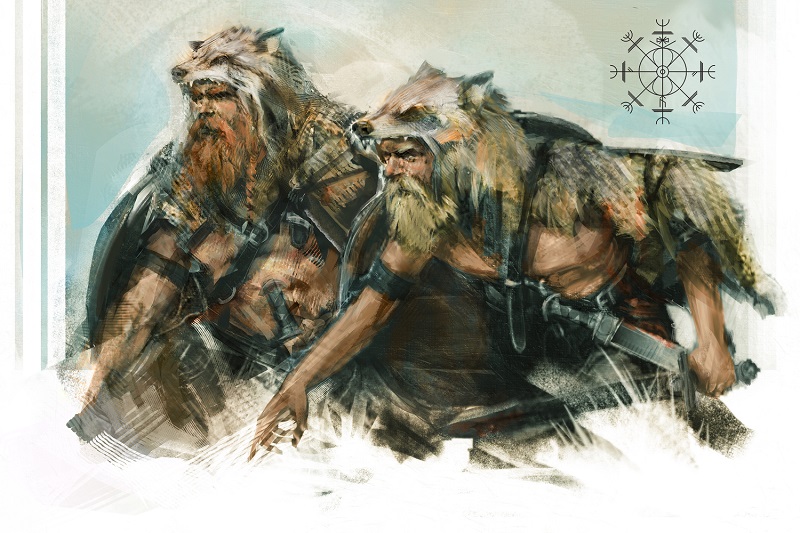It was well known that Berserkers had no fear and were not subject to the same rules as other humans or soldiers. In fact, some speculated that the Berserkers weren’t human anymore but had instead become some sort of shapeshifter. Regardless of what the Berserkers were – human or animal – they inspired fear whenever they were summoned.
What is the Berserker?
Berserkers were an elitist fighting group and secret shamanic society. These men were said to acquire their great strength and power through ritualistic practice that led them to live extreme lifestyles. Berserkers were said to live in the woods and endured extreme conditions in their attempts to harness the power of their chosen animal cult: the bear, the wolf, or the hog. Though each of these cults have their own names, they are generally recognized in modern day as berserkers above all else.
Origins of the Name ‘Berserker’
There are several theories as to the origin of the name ‘Berserker.’ The first theory claims that ‘ber’ was meant as ‘bare’ while ‘serkir’ translated to shirt. The combined phrase meant ‘bare of shirt’ which supposedly described the near nude state in which Berserkers were known to enter battle.
Others argue that ‘ber’ should actually be seen as ‘berr’ – the Norse word for bear. This was thought to describe the bear cult of these famed warriors, who were known to closely guard the King. This theory has caused many historians to abandon the ‘bare shirt’ theory.
Possible Ties to Magic
It is thought that the Berserkers, like other northern warriors, began their traditions in hunting magic. This is perhaps why the different cults adopted animal representations as the head of their groups. It is important to note that although the Berserkers were known for their ruthlessness and violence, they were also very religious. In fact, there are stories that tell of a Berserker who was challenged to fight and postponed the duel for three days to accommodate a religious celebration.
Although the Berserkers were known to be a highly religious cult, their idea of religion was very different from what we think of today. Similarities can be found in their self-control, spiritual connection to their religious figures, and strict training. However, the similarities end there. Berserkers were not opposed to violent behavior and were so ruthless with their actions that they are thought to have tarnished the reputation of the entire Norse culture.
The Berserkers Gave the Norse a Bad Rep
When we think of the Norse and the Vikings, we often think of large brutes who pillaged villages, stole from their own, and spilled blood wherever they went. However, the Norse themselves were actually quite peaceful people and even had high standards for gender equality in their day. The Berserkers however, were another story. These men were so brutal that they raped and pillaged towns without discrimination.
Some of the harshest critiques of the Berserkers came from their habit of destruction and devastation – even among their own people. This is likely part of the reason their group was later outlawed. The Berserkers were known to pillage and burn down villages, kill livestock, kill men and women indiscriminately, and rape both married women and virgins. They were known to be similar to vicious animals and were feared by all when they went into their state of frenzy – often known as berserkergang.
Berserkergang
Berserkergang was a terrifying sight to behold. Commonly, this state caused warriors to go into a state of hysteria and frenzy so extreme that they couldn’t differentiate friends from foes. They would cut down any living thing in their path without remorse – often while engaging in other terrifying behavior. Many accounts of Berserkers speak of their tendencies to bite at (and even eat) the metal at the edges of their shields and one account even mentions a Berserker who swallowed a fire ember.
Although berserkergang was most commonly seen in battle, there were also instances where the transformation could be seen in Berserkers who were trying to perform the impossible while working. They would go into a frenzied trance in which they could not be disturbed by any outside force and could not be harmed by fire or weapons made of iron.
Reaching the berserkergang state was considered a rite of passage into their cult world. Men would train in the woods for years to become worthy enough to join the ranks of the elite. They braved the code, adopted the habits of their patron animal, and drank the blood of wolves, hogs, and bears.
Life of a Berserker
Berserkers lived without the same sorts of luxuries that the rest of the Norse had access to. However, they weren’t resentful of this. Rather, they embraced it. On of the most telling aspects of this is that they gnawed at the edges of their shields and commonly threw their swords and shields aside before battle. When the Norse reached manhood, they were given a sword and shield by their father. This was considered to be among their most precious possessions and they looked after these things diligently. For the Berserkers to throw them aside with such indifference shows that they have forgotten the cares of men and have instead risen above to a higher level.
The great spirituality and discipline with which the Berserkers practiced leads some to believe that the cult could have developed a level of martial arts that would have been comparable to that of the Japanese culture. The Berserkers were so dedicated to their craft that they were often recorded in historical texts as being animals instead of human. This was considered to be a great achievement as the Berserker’s main goal was to transform into their cult’s animal. There are some accounts in history that claim a few Berserkers were successful with this and were actually shapeshifters, though most scholars agree that it was likely a hyperbole.
Perhaps one of the most noted features of the Berserkers was their ferocious demeanor. These men were capable of terrifying feats and were known to strike fear into the hearts of anyone unfortunate enough to cross their path. But what made them so terrifying?
There are several theories as to how the Berserkers were able to gain so much strength and power. One of the most popular is that the Berserkers used psychedelics and alcohol to enter their intense and frenzied trances. Both of these things are thought to fit the specifications for substances that could have been used in Viking rituals and would go a long way in explaining the bizarre behavior of the Berserkers. It is hypothesized that Amanita muscaria – a type of psychedelic mushroom – could have been used regularly by the Berserkers. If so, this would explain many of the symptoms related to the berserkergang trance.
There are also psychological reasons that the Berserkers were able to access a state of frenzy so easily. Some historians hypothesize that Berserkers were genetically predisposed to severe mental illness. Others claim the cult had mastered the ability to self-induce hysteria in their ranks. Still, others claim that a more serious underlying issue like epilepsy could be to blame. Regardless of what the cause was, the Berserkers were able to access a part of themselves that few others have been able to reach to this day.
Physical Appearance
Berserkers were the most elite of the Viking ranks and were known to strike fear into the hearts of anyone who encountered them. The brutes were known to pillage villages and wreck havoc on anything they happened across, making them one of the most feared cults in history.
Berserkers are known to be extremely powerful and self-disciplined. While some of this power undoubtedly comes from their intense training regimen in the wilderness, many believe that Berserkers were granted strength beyond human capabilities when they went into the berserkergang trance. This trance allowed them to perform feats that were considered impossible.
Berserkers were also known to have an inhuman look about them. Some records say that their appearance featured that of a troll more so than a human. Other accounts claim that the Berserkers were prone to swelling in the face when they went into their rage-filled trance. During this time they raged like beasts and tore down every living thing in their path until the end of the battle. Then, they collapsed to the ground – exhausted from their fighting and too weak to move.
Berserkers were also known to go into battle without the traditional armor. In fact, they didn’t see much use for protection at all. They strode into battle with only the pelt of their cult animal to cover them and gnawed at their swords and shields while they waited for the battle to begin. Many historical accounts make mentions of Berserkers who actually at their weapons before they engaged in battle. Afterwards, they tossed aside what remained of the weaponry and tore through the battle field. They often ripped enemy soldiers apart with their bare hands and delivered vicious, fatal bites with their teeth. There was no differentiating between friendly soldiers and enemy soldiers – they simply killed anyone in their path.
There are also multiple historical accounts that claim the Berserkers couldn’t be harmed by fire or iron. There are rumors of Berserkers who literally ate fire to prove how crazy they were before attacking their enemies. There are also claims that Berserkers could take away the sharpness of a blade of iron simply by looking at it or by casting a spell in its direction. This is thought to be an ability that was obtained through their shamanistic practices – though it could just be another exaggeration to emphasize how amazingly powerful these troops were.
Berserkers
Of all the ranks of the shamanic Norse cult, the Berserkers were the most well known. It is from them that we know the English word ‘berserk’ – to describe their state of delusion, hysteria, and frenzy. The Berserkers were the bear warriors. This cult was one of the most wide spread across the entire northern hemisphere. In fact, you can still see remnants of their order in the guards of Danish and British royalty. Both the Royal Life Guards and the Queen’s Guard wear bear skin caps to show their history of bear warriors.
This cult order wore bear pelts into battle and lived by the code of the bear. When they died, their bodies were laid out on bear skins before their funerals to symbolize the life that they had lived.
Ulfheonar
Wolf warriors were also revered among the ranks of the Berserkers, though they were properly known as the ulfheonar. This particular rank was well known among Norse culture, but also survives through Roman culture thanks to the shields that were recovered by Roman soldiers. These items were put on display in the armilustrium.
Wolf warriors are also found throughout other ancient cultures, most notably the Mongols and Native Americans.
The order of the wolf warriors was highly respected by the rest of the Norse culture. This particular cult was thought to be one of the most powerful, since these soldiers were often referred to as ‘Odin’s Men.’
Svinfylking
Last, but not least, the Svinfylking consisted of the boar warriors. The wild boar was thought to be beloved by the god Freyr and the goddess Freyja. These warriors were well known in the Norse culture, though in addition to their ruthlessness, they were recognized as being masters of both disguise and escape. They used these talents to give themselves an advantage on the battlefield.
Legacy of the Berserkers
Though not necessarily connected to a secret society or shamanic practices, in the Malay culture there have been documented cases of Berserker-like activity. In these cases, individuals who have no past history of violence or uncontrollable rage will acquire a weapon and attempt to murder as many people as they possibly can before ending their rampage with suicide or being killed by an intervening presence like the police. This behavior also gave way to a commonly used expression; ‘Running Amok.’
Explanation of the Myth
Though many aspects of the Berserkers have likely been exaggerated, this cult of super-warriors was very real. They have a very unique history, though many of their beliefs and practices remain a mystery today.





